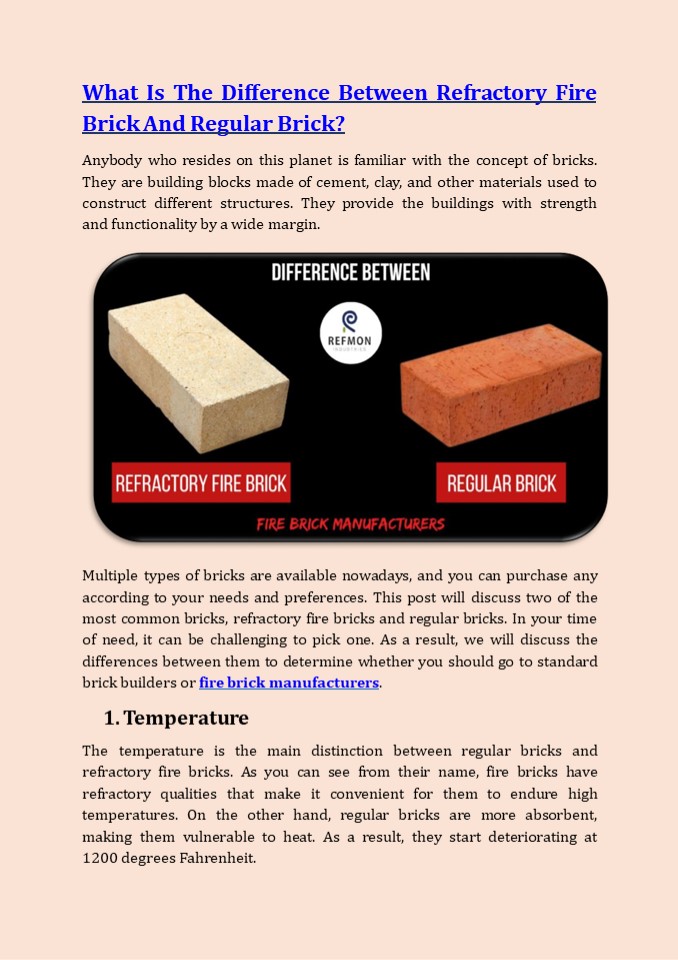Difference Between Refractory Fire Brick And Regular Brick - PowerPoint PPT Presentation
Title:
Difference Between Refractory Fire Brick And Regular Brick
Description:
Know the difference between refractory fire brick and generic bricks in detail, if you want to make the best choice, then you need to choose the best brick manufacturer. Refmon Industries will help you to choose the best bricks. You will learn more about the differences in this blog. – PowerPoint PPT presentation
Number of Views:6
Title: Difference Between Refractory Fire Brick And Regular Brick
1
What Is The Difference Between Refractory Fire
Brick And Regular Brick? Anybody who resides on
this planet is familiar with the concept of
bricks. They are building blocks made of cement,
clay, and other materials used to construct
different structures. They provide the buildings
with strength and functionality by a wide margin.
Multiple types of bricks are available nowadays,
and you can purchase any according to your needs
and preferences. This post will discuss two of
the most common bricks, refractory fire bricks
and regular bricks. In your time of need, it can
be challenging to pick one. As a result, we will
discuss the differences between them to
determine whether you should go to standard
brick builders or fire brick manufacturers. 1.
Temperature The temperature is the main
distinction between regular bricks and
refractory fire bricks. As you can see from their
name, fire bricks have refractory qualities that
make it convenient for them to endure high
temperatures. On the other hand, regular bricks
are more absorbent, making them vulnerable to
heat. As a result, they start deteriorating at
1200 degrees Fahrenheit.
2
- Because of this factor, you should use fire
bricks if you want to build an oven, fireplace,
or wood chamber. Industrialists can also seek a
manufacturer's advice to learn more about regular
and refractory bricks if they are unsure which
type to select. - Composition
- The second factor contributing to their
differences is the chemical and physical
composition of the two bricks. Alumina and silica
create 23 percent and 73 percent, respectively,
of the several components that are present in
fire bricks. Not only that, but they are also
composed of several metallic oxides, including
titanium, ferric oxide, and other materials. - These elements increase the strength of the
bricks by a wide margin. On the other hand,
regular brick contains substances like silica,
alumina, magnesia, lime, iron oxide, and other
alkalis. You cannot reduce the quantity of these
components without harming the bricks. The
refractory material is denser when compared to
ordinary bricks. - Appearance
- Refractory fire bricks and general bricks differ
from one another in two ways. You can
effortlessly tell these two building blocks apart
because they are available in different colors
and shapes. Fire bricks are distinguished from
other materials by their bright white color. - These types have several colored stains which
blend throughout the production process to tint
the bricks. As a result, they are available in
different hues. You can match the refractory bed
material to the surroundings using this aspect.
On the other hand, regular bricks are colored by
the soil used in their production. Therefore,
they are usually brown. - Heat Conduction
- Finally yet importantly, heat conduction adds to
the differences between the two brick types.
Both have different heat conduction qualities
because of the materials used in their
production. Fire bricks can absorb high
temperatures without transferring them to other
locations because they contain ceramic and
ferric oxide.
3
You can save a significant amount of energy with
the help of this factor. As a result, dense fire
bricks are super popular and appreciated in the
business world. On the other hand, general bricks
are poor heat conductors since they are composed
of mud and soil. Conclusion You should learn the
difference between castable refractory and
generic bricks in detail if you wish to make the
best choice. If this is your first time choosing
bricks, you can take the help of an expert or a
business like Refmon Industries. You will learn
more about the differences in this blog. Source
Link https//shortkro.com/difference-between-refr
actory-fire- brick-and-regular-brick/































